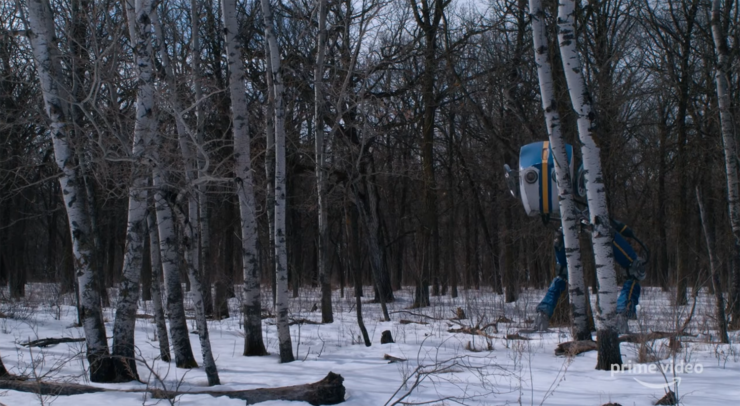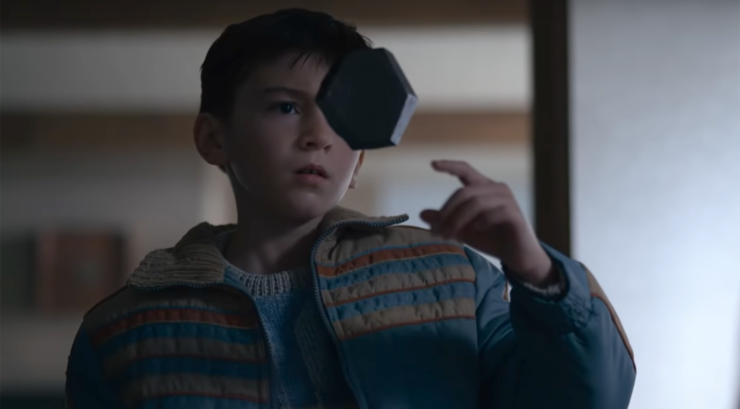Giant buildings loom over the distant skyline, while giant robots and machines dot the surface of a rural landscape. Those elements make up many of the paintings that Swedish artist Simon Stålenhag has produced over the years, and which are now the basis of a new series from Amazon Prime Video, Tales From the Loop.
Stålenhag has risen to prominence in recent years with his nostalgia-laced art, which he has since published in a pair of art books, Tales From the Loop and Things from the Flood. (Another, Electric State, reflects much of the same format, but isn’t set in the same world.) Featuring stark, haunting images of a sort of urban decay, on their surface they seem like an unlikely source for a dramatic television series. But Amazon’s Tales From the Loop is an intriguing, beautiful series that looks for the humanity amidst the fantastical.
[Spoilers ahead for the first, third, and sixth episodes of Tales From the Loop.]
The ongoing boom in streaming video has led to plenty of high-profile book adaptations, including Game of Thrones, The Expanse, The Witcher, His Dark Materials, Lord of the Rings, Foundation, among others. But Tales From the Loop is probably the strangest pick for a show. The art book is less of a linear narrative and more a collection of vignettes, memories, and observations of a fantastic, fictional world.
Stålenhag’s art could easily have served simply as concept art for a series, but Amazon recognized that the appeal of Stålenhag’s stories extends beyond just the extraordinary moments that he depicts in his scenes: it’s in the atmosphere, the sense of nostalgia, and the normalization of extraordinary circumstances that his art evokes. The new series captures that while also building on Stålenhag’s artwork, setting up a series of episodes that explore the humanity present in this alternate, retro-futuristic world.

In the opening moments of the pilot, we learn that the town of Mercer, Ohio is home to The Mercer Center for Experimental Physics, a particle accelerator known to locals as “The Loop.” Its purpose, we’re told, is to “unlock and explore the mysteries of the universe.” The Loop seems to have had a strange impact on its surroundings and the people who reside there, creating unexplained phenomena and warping time in unexplained ways.
Set against that background, show creator Nathaniel Halpern—best known for FX’s Legion—sets up a sort of anthology series. Unlike anthology shows like Black Mirror and The Twilight Zone, which feature standalone casts and episodes, Tales From the Loop’s episodes are connected by common elements and characters in their world and but which otherwise stand on their own.
In the first episode, “Loop,” a young girl named Loretta (Ant Man and the Wasp’s Abby Ryder Fortson) discovers that her home has mysteriously vanished. As she looks for her home in the woods, she’s aided by a young boy—Cole (played by Camping’s Duncan Joiner), whose mother turns out to be an older version of herself. The show’s third episode, “The Echo Sphere,” follows Russ (played by Game of Thrones’ Jonathan Pryce) and Cole (his grandson) as they visit a giant metallic sphere which will tell you how much longer you have to live. Cole hears echoes of his own voice, each of which sounds older and older, until he’s an old man; Russ doesn’t merit any echos. The show’s sixth episode, “Parallel” follows Gaddis (played by Altered Carbon’s Ato Essandoh), who works on a dilapidated hover-tractor on his property and is enamored of the photograph of its owner. When he eventually turns it on, he suddenly finds himself face-to-face with an alternate version of himself, married to Alex (played by Jon Kortajarena), the man in the photograph.
Buy the Book


Flyaway
Each episode of the series uses Stålenhag’s art as a jumping-off point, while elements from other paintings—like the three cooling towers that appear in “The Bona Plant and Ossian”—help flesh out the landscape. But they’re not literal translations from one medium to another. Episode Three, “The Echo Sphere,” uses the painting by the same name from the book, which is paired with the following description: “I have a vague memory of my grandfather taking me to Munsö once, when I was around four. I remember a big, hollow steel sphere. We walked into it. My voice echoed in there like I was in a church.”
Halpern builds on that description, adding in a fantastical mechanism through which his characters explore their relationships with one another—a child realizing that his grandfather isn’t the immortal presence that he thought he was. The result is a series that replicates Stålenhag’s view into his imaginary, alternate realm: a series of stories that collectively build a distinct world, connecting and overlapping.
Where the show most closely replicates Stålenhag’s art is in the cinematography itself: it captures the sense of isolation and calm quiet that Stålenhag depicts, utilizing slow pan and symmetrical shots, full of wide-open spaces. It’s utterly gorgeous, and as the visuals complement the stories that they surround.
What Tales From the Loop does most effectively is focus extensively on the emotional core of how each character relates to their surroundings. Loretta loses her mother (and time, as it turns out); Cole has to come to terms with his grandfather’s mortality, while Gaddis comes face to face with a different version of his life. Viewers looking for straight-forward explanations for why characters suddenly find themselves in an alternate reality, or why a giant metallic sphere of metal can tell their future are missing the point: this is a show about the journey, rather than the directions from point A to B.
It’s easy to see how another writer might have relied on Stålenhag’s artwork as a straightforward jumping-off point for a more familiar kind of TV narrative, maybe injecting some sort of science fiction story about the characters fighting an otherworldly menace à la Stranger Things (a show that Tales From the Loop is being compared to, perhaps inevitably). Instead, Halpern uses these emotional stories and striking sense of place to build up his unique world. The robots that dot the landscape and retro-futurist architecture are treated more as background scenery while the characters work out the personal issues and relatable anxieties, fears, and worries that crop up in everyday life. It’s these moments—a child terrified at the realization that his grandfather won’t be around forever, or a man comprehending the extent of his loneliness—that transform Stålenhag’s beautiful paintings into an equally beautiful tapestry of humanity, set against a fantastical backdrop of robots, brutalist buildings, and strange, otherworldly phenomena.
Andrew Liptak is a writer and historian from Vermont. He is the author of the forthcoming book Cosplay: A History (Saga Press, 2021), and his work has appeared in Clarkesworld Magazine, io9, Kirkus Reviews, Lightspeed Magazine, Seven Days, Tor.com, VentureBeat, The Verge, and other publications. You can visit his website, follow him on Twitter, or subscribe to his newsletter.










